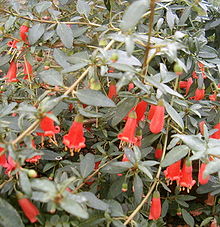- Correa pulchella
-
Salmon Correa 
Scientific classification Kingdom: Plantae (unranked): Angiosperms (unranked): Eudicots (unranked): Rosids Order: Sapindales Family: Rutaceae Genus: Correa Species: C. pulchella Binomial name Correa pulchella
SweetSynonyms - Correa minor (Ashby) J.M.Black
- Correa neglecta Ashby
- Correa reflexa var. pulchella (J.Mackay ex Sweet) Court
- Correa rubra Smith var. pulchella (Sweet) J.M. Black
Correa pulchella (Salmon Correa) is a small shrub which is endemic to South Australia.[1] It grows to between 0.3 and 1 metre in height and 1 to 2 metres in width. The leaves are linear-oblong to broadly ovate. The pendent, tubular flowers appear between April and September in the species native range.These are pink-red, orange, or rarely white and have yellow anthers.[1]
Taxonomy
The species was first formally described in 1827 in Flora Australasica with reference to plants grown by J. Mackay at his Clapton Nursery in England. The plants had been raised from seed collected from Kangaroo Island by William Baxter. [2]
Cultivation
Correa pulchella is regarded as one of the most attractive Correa species.[3] It prefers dry summers with low humidity and well-drained alkaline soils.[3] Propagation from seed is difficult, howewer semi-mature stem cuttings strike readily.[3]
Cultivars include:
- 'Little Cate', a seedling selection of garden origin with prominently displayed bright pink flowers. It is thought to be a hybrid between two different forms.[4]
- 'Pink Mist', a pale-pink flowering form selected from a wild population on the southern Yorke Peninsula .[5]
References
- ^ a b "Correa pulchella J.Mackay ex Sweet". Electronic Flora of South Australia Fact Sheet. State Herbarium of South Australia. http://www.flora.sa.gov.au/cgi-bin/texhtml.cgi?form=speciesfacts&family=Rutaceae&genus=Correa&species=pulchella. Retrieved 2009-05-07.
- ^ "Correa pulchella". Australian Plant Name Index (APNI), IBIS database. Centre for Plant Biodiversity Research, Australian Government, Canberra. http://www.anbg.gov.au/cgi-bin/apni?TAXON_NAME=CORREA+PULCHELLA. Retrieved 2009-05-07.
- ^ a b c "Correa pulchella". http://asgap.org.au/c-pulc.html. Retrieved 2009-05-07.
- ^ "Correa 'Little Cate'". Australian Cultivar Registration Authority. http://www.anbg.gov.au/acra/descriptions/acc1127.html. Retrieved 2009-05-06.
- ^ "Correa 'Pink Mist'". Australian Cultivar Registration Authority. http://www.anbg.gov.au/acra/descriptions/acc392.html. Retrieved 2009-05-06.
Categories:- Correa
- Flora of South Australia
- Rutaceae stubs
- Australian rosid stubs
Wikimedia Foundation. 2010.
